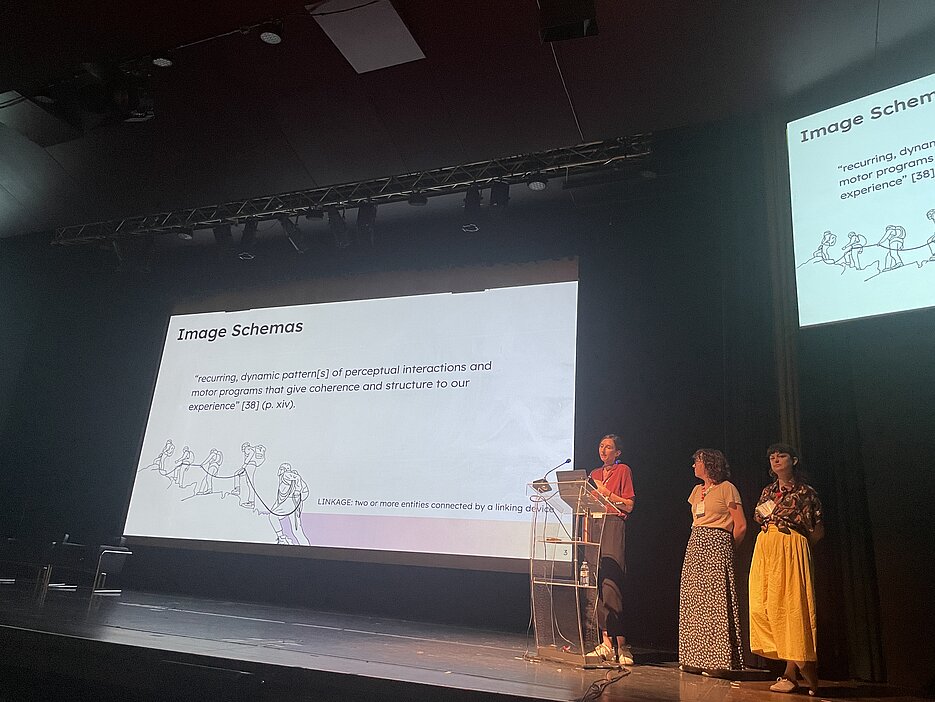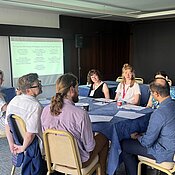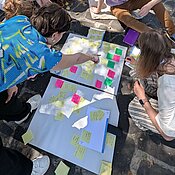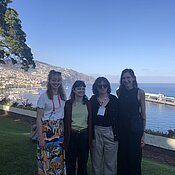PsyErgo auf der DIS‘25 Konferenz in Funchal, Madeira, Portugal
30.07.2025Cordula Baur, Tamara Friedenberger, Franzisca Maas und Nathalie Pappenfuß besuchten in diesem Jahr die DIS-Konferenz auf Madeira.
Die ACM Conference on Designing Interactive Systems (DIS) ist eine bedeutende Konferenz, die sich mit der Gestaltung neuer interaktiver Technologien beschäftigt. Dieses Jahr trafen sich Designer:innen, HCIler:innen, Informatiker:innen und Interessent:innen in der Hauptstadt Madeiras, um ihre aktuelle Forschungsarbeiten zu präsentieren und diese zu diskutieren sowie sich mit anderen Forscher:innen zu vernetzten und auszutauschen.
Die PsyErgos stellten in insgesamt vier Workshops ihre Forschung vor:
Franzisca Maas co-organisierte den Workshop „Diving Into the Ocean of Religious and Spiritual Design Research“, indem es um die Applikation von Eigenschaften des Ozeans, wie transzendent, mystisch oder fluide, als Metaphern der Religiosität/Spiritualität in der HCI-Forschung ging. Zu den facettenreichen Aspekten der Anwendung ozeanischer Begrifflichkeiten stellte Nathalie Papenfuß die aktuelle Arbeit von ihr und Sara Wolf mit dem Titel „Speculative Probe Items to Capture Fluid Religious and Spiritual Belonging in HCI“ vor.
Cordula Baur stellte im Workshop „Design Knowledge in AI: Navigating Temporality and Continuity“ ein Position Paper vor und Tamara Friedenberger präsentierte ihre Forschung in gleich zwei Workshops „Haka’a’Museum: Designing for a Sustainable Ocean” und „Bring Your Own Biodata (BYOB): Feminist, Corporeal and Collective Approaches to Datafied Bodies”.
Gemeinsam präsentierten Cordula Baur, Tamara Friedenberger und Franzisca Maas das Pictorial “LINKING THEORY AND PRACTICE: Developing an Image-Schema-based Design Tool for Closeness Technologies”, welches aus dem SPIELEND Projekt, gefördert durch das Bundesministerium für Forschung, Technologie und Raumfahrt, entstanden ist.
LINKING THEORY AND PRACTICE: Developing an Image-Schema-based Design Tool for Closeness Technologies
Abstract:
People use technology to stay in touch with their family and friends. To design novel technologies that bring us closer, the theoretical concept of image schemas is a perfect fit. Image schemas are abstract representations of embodied experiences which can be used to design intuitive, inclusive and innovative technologies. However, their application in design processes requires additional effort and time, while existing design tools often lack a theoretical foundation for social closeness. To address this gap, we sourced domain specific image schemas and conducted iterative user-centered research through design, to create an easy-to-use image schema design tool which facilitates the creation of closeness technologies. In this pictorial, we document our process and provide a design tool that connects theory with actionable design strategies, providing designers with clear guidance and a practical tool for metaphorical integration. The tool can be found at https://osf.io/twndg/.
Referenz:
Cordula Baur, Tamara Friedenberger, Franzisca Maas, Louisa Maurer, and Jörn Hurtienne. 2025. LINKING THEORY AND PRACTICE: Developing an Image-Schema-based Design Tool for Closeness Technologies. In Proceedings of the 2025 ACM Designing Interactive Systems Conference (DIS '25). Association for Computing Machinery, New York, NY, USA, 2313–2327. https://doi.org/10.1145/3715336.3735418
Diving Into the Ocean of Religious and Spiritual Design Research
Abstract:
Religion and spirituality (R/S) are deeply ingrained in everyday life and are an essential aspect of many individuals’ existence. Human Computer Interaction (HCI) is progressively engaging in research and design within specific R/S contexts. Building on previous workshops organized by the SPIRITED Collective, this workshop will focus on the under-explored intersections of R/S and HCI design research, drawing from oceanic notions of fluidity, mystery and depth of the unknown, transcendence, and sustainability and resilience. Participants will reflect on their experiences, uncover common research priorities, and develop joint approaches to investigate the intersection of R/S and design. Through the workshop, participants will gain insights into R/S to inform their research and design work. Collectively, we hope to strengthen our network and disseminate our work.
Referenz:
Alexandra Kitson, Brett A. Halperin, C. Estelle Smith, Franzisca Maas, Michael J Hoefer, Sara Wolf, and Elizabeth Buie. 2025. Diving Into the Ocean of Religious and Spiritual Design Research. In Companion Publication of the 2025 ACM Designing Interactive Systems Conference (DIS '25 Companion). Association for Computing Machinery, New York, NY, USA, 47–51. https://doi.org/10.1145/3715668.3734166
Speculative Probe Items to Capture Fluid Religious and Spiritual Belonging in HCI
Abstract:
With this submission, we respond to the workshop’s theme of fluidity and explore how religious and/or spiritual (R/S) belonging might be captured in Human-Computer Interaction (HCI) projects that take R/S fluidity seriously. We make a case for probes as a useful approach and present speculative examples of potential probe items to capture fluid R/S belonging. The examples are rooted in an ongoing interdisciplinary project between Protestant theology and HCI, SoulMate, that explores ways to support young adults in navigating existential questions.
Referenz:
Papenfuß, Nathalie, and Sara Wolf. “Speculative Probe Items to Capture Fluid Religious and Spiritual Belonging in HCI”. Madeira, Portugal: DIS’25 Workshop, 2025. https://publications.wolf-research.com/2025-dis-ws-soulmate.pdf .






